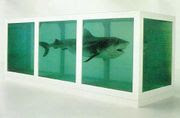A travelling show, ‘On High Ground of Indian Art: Eastern and Southern dimensions’ presents works by 13 artists representative of Indian art from the 1940s to the turn of the 21st century. The show tries to capture the influences that shaped the art of these prominent artists and attempts to present it in a contextual format. Paritosh Sen, Suhas Roy, SG Vasudev, Rekha Rao, Laxman Aelay are some of the artists whose works are part of this exhibition.
The Victim, an acrylic on canvas work by Paritosh Sen, focuses on the aftermath of the tsunami. The poignant image of the young girl sitting in the forefront with sketches of dead children and fish behind her paints a picture riddled with grief and trauma. The Landscape by Surya Prakash is a melange of colours that presents nature in all its majestic beauty. The Hyderabad based artist is known for his beautiful landscapes. The Chennai based artist K Muralidharan combines folk art elements in his mixed media work on canvas to weave a visual narrative. Despite borrowing motifs from folk art, the images are surreal where hybrid creatures are a combination of human and animal forms to create a fantasy world.
 Palaniappan’s abstract is in his inimitable minimal style - the linear trajectories on the artist’s canvas project scientific precision on to the creative world of art. Subroto Gangopadhyay’s works are a riot of colours that capture the festive spirit. The dancing figures appear lyrical as they move energetically to the musical rhythm. Suhas Roy’s painting belongs to his popular Radha series that effectively presents his unique style.
Palaniappan’s abstract is in his inimitable minimal style - the linear trajectories on the artist’s canvas project scientific precision on to the creative world of art. Subroto Gangopadhyay’s works are a riot of colours that capture the festive spirit. The dancing figures appear lyrical as they move energetically to the musical rhythm. Suhas Roy’s painting belongs to his popular Radha series that effectively presents his unique style.Most of the other works are also representative of the artist’s signature style. For the viewer who is unfamiliar with the progression of Indian art at various time points, the exhibition offers an opportunity to look at some quality works by well known artists.
(The exhibition ended at Venkatappa Art Gallery, Bangalore and will head to Kolkatta)
Published in Bangalore Mirror






 The gallery promises to hold art appreciation and other workshops in addition to regular exhibitions.
The gallery promises to hold art appreciation and other workshops in addition to regular exhibitions.
















 For so many successful artists this can be such a vicious trap – they are forced to paint what the buyers want, but then critics pan them for repeating their works and not trying out anything new. A Catch 22 situation for them, don’t you think? Maybe sometimes we are too quick in judging artists; it helps to remember that at the end of the day this too is a profession for them. Artists also need to make ends meet and have families to support.
For so many successful artists this can be such a vicious trap – they are forced to paint what the buyers want, but then critics pan them for repeating their works and not trying out anything new. A Catch 22 situation for them, don’t you think? Maybe sometimes we are too quick in judging artists; it helps to remember that at the end of the day this too is a profession for them. Artists also need to make ends meet and have families to support.




